Stories > Pouring Their He(Arts) Out
Pouring Their He(Arts) Out
Arts practitioners from different parts of the world gathered in the Indian capital for the latest edition of the Singapore International Foundation’s Arts for Good Fellowship.
BY ZHOU XIJIE
he Singapore International Foundation (SIF) has always believed that people are the world’s most valuable resource who collectively hold the key to a better future for everyone. It envisions a world where, regardless of their backgrounds, people can freely express their dreams and aspirations through channels such as the creative arts.
Staying true to this conviction, the SIF held its third Arts for Good (A4G) Fellowship exchange programme this January, gathering 33 arts educators, practitioners and programmers from 12 countries with the aim of using art to evoke positive change in marginalised communities. Like previous editions, the latest fellowship featured two exchange programmes. The first took place in Singapore, where participants exchanged insights into their respective disciplines while brainstorming community-based initiatives to implement during the second exchange in Delhi, India a few months later.
Over several days in the Indian capital, A4G fellows worked alongside students attending programmes by non-profit organisations NalandaWay Foundation (NW), the SIF’s main partner for the exchange, and Slam Out Loud (SOL). Reflecting on the theme “What I Want to Tell the World”, they helped these young individuals showcase how poetry, music and the visual arts can be a form of personal empowerment for marginalised communities.
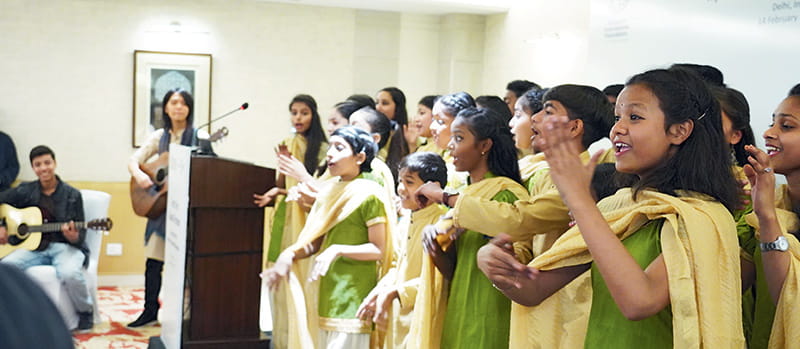
The Delhi Children’s Choir, comprising children from disadvantaged communities, worked with the SIF fellows to create a song in multiple languages.
SLAM OUT LOUD
Since its founding in 2014, SOL has harnessed the transformational power of poetry to help disadvantaged children find their voices and express themselves. “Art comes naturally to all of us,” says its founder Jigyasa Labroo, a 2018 A4G fellow. “We’ve been acting, singing, drawing since time immemorial, and it does not require a minimum literacy level to become an artist. Artistic pursuits can restore dignity along with thriving interest, even for the most marginalised, and that is extremely powerful.”
SOL worked with 2019 fellows to experiment using various disciplines such as visual arts, drama, photography and puppetry to inspire poetry related to the theme “What I Want to Tell the World”. Children who are a part of SOL facilitated a poetry workshop for the fellows. In return, the fellows conducted a theatre workshop for the kids. The initiative culminated in a poetry showcase for 500 students from a local boys’ senior secondary school.
“Engaging With The A4g Fellowship Was A Reinforcement Of Our Belief That Art Is The Most Powerful Medium To Express, Communicate And Co-create Beyond The Boundaries Of Language, Nationality And Socio-economic Identities.”
While the fellows led the process, they too benefitted from the experience. “I felt that the participants gifted me more than I contributed to them,” says Teng Ziying, who is the deputy lead at YouthReach, the street outreach arm of Boys’ Town in Singapore. “When brainstorming for the performance, the group of girls I was working with were offering a steady stream of social issues they wanted to present, such as letting girls stay in school, the importance of caring for our environment, and demolishing factories that engaged child labour. I left the first session thinking: ‘They are the ones empowering me instead!’”
Hannah Grant, an Australian arts practitioner, points out that the fellowship has been critical in helping fellows expand their horizons and view their own work from another perspective. Such fellowships are important, she says, because they promote the proper way of using art to do good. She further explains that if not utilised correctly, the arts can instead be a “disempowering” experience. For example, if there is a focus on talent and competition and a definition of right and wrong, the arts can discourage individuals from expressing themselves.
“Our role is to make sure we are building equitable, accessible spaces, where the arts offer creative ways for people to express and empower themselves, and share their own voices. That is why this fellowship is so important – it brings together people like us who are focused on this kind of practice.”
This initiative has also been an eye-opening experience for Labroo, who thanked the SIF for facilitating the exchange among its fellows, members of SOL and stakeholders from the art community.
“Engaging with the A4G Fellowship was a reinforcement of our belief that art is the single most powerful medium to express, communicate and co-create beyond the boundaries of language, nationality and socio-economic identities.”
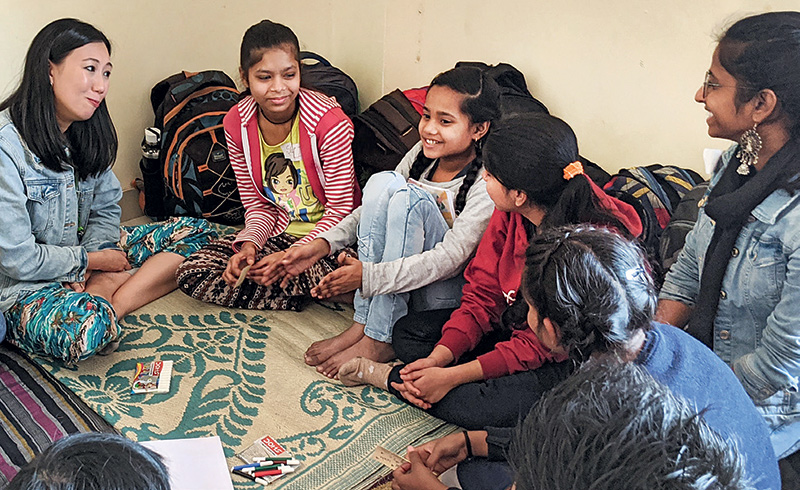
Children from Slam Out Loud, a non-profit organisation that uses poetry to help empower disadvantaged children in Delhi, presented their creations.
In fact, just shortly after the conclusion of the Delhi initiatives, Labroo collaborated with two other members of the 2019 fellowship – Kristin Dwek and Chhavi Khandelwal – to host a livestreaming arts activity session for the SOL children.
In particular, this involved Khandelwal’s organisation, Saturday Art Class – which teaches a formal art-based curriculum to help students in government and lowincome aided schools focus on social and emotional learning.
“Although we are now learning to navigate the new normal created by Covid-19, we are still committed to making children’s voices heard everywhere. We’ve created art activities that are reaching children through WhatsApp and phone calls, and are consistently working on reaching children on the dark side of the digital divide,” says Labroo.
DELHI CHILDREN’S CHOIR
Another project that the 2019 fellows were involved in was the Delhi Children’s Choir (DCC), an initiative by the NW that uses the performing arts to help children from disadvantaged communities improve their learning abilities and grow in confidence through self-expression.
“The Biggest Takeaway From The Fellowship Was The Opportunity To Interact With Artistes, Educators And Social Entrepreneurs From Around The World. I Have Been Able To Learn From Them, Apply Them In Our Work With Disadvantaged Children, And Forge Partnerships.”
Sriram Ayer, Founder, Nalandaway Foundation
During the exchange programme, fellows worked with members of the choir to create a song that featured a mix of genres and languages: English, Mandarin and Hindi. Despite the language barrier, the children clearly took matters in their stride, evidenced by the standing ovation they received after their performance. “The biggest takeaway from the fellowship was the opportunity to interact with international artistes, educators and social entrepreneurs. I have been able to learn from them, and apply them in our work with disadvantaged children and forge partnerships,” says Sriram Ayer, the founder of the NW, and an alumnus of the inaugural 2017 A4G Fellowship.
Among those involved in this initiative was Anurag Hoon, the CEO and co-founder of Manzil Mystics, a non-profit organisation that creates positive change in the lives of children through music. He has, for the past few years, been playing a key role in curating the music at the DCC.
“In the past 10 years, I have hardly collaborated with non-musicians. But this project has allowed me to meet artists from various disciplines, bringing them together to create a beautiful rainbow. I have since started making it part of my curriculum.”
For Rebekah Lin, who runs The Social Co. – a Singapore-based movement that encourages millennials to give back to society – the fellowship proved to be a humbling and enriching experience. “We are the lucky ones because we witnessed such talent and heard their stories. I was humbled at this opportunity to learn from every single person in the room,” she says. “We all have stereotypical views of each other, so I was grateful for the gentle nudging from the community leaders to listen intently to work on suggestions together.”
The exchange has also opened new doors to facilitating social change for Lin, who shares that she will be embarking on a new project, Arts in Focus in Southeast Asia (ArtSEA), with Singapore-based American fellow Dwek and Teng. As its name implies, ArtSEA aims to create a digital arts resource package that highlights 10 regional artists that will be used to connect children and youth from different cultural backgrounds and increase their access to local art forms.
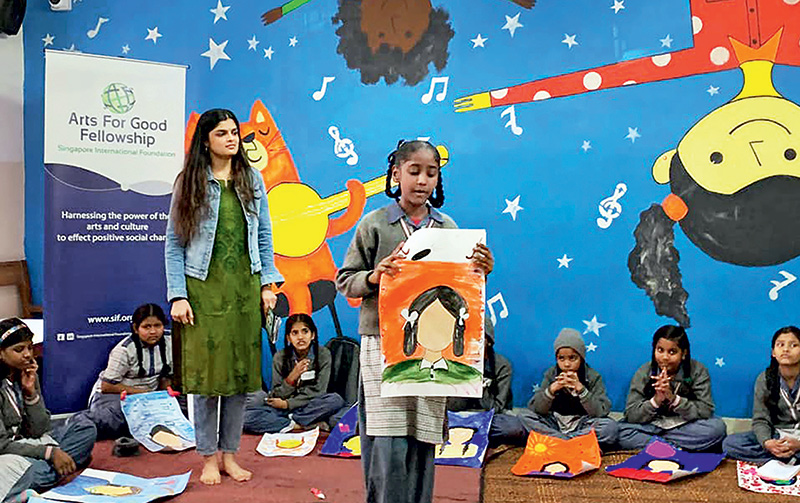
India non-profit NalandaWay Foundation facilitated Art Lab, where the SIF’s A4G fellows worked with local children to harness the power of visual arts as a form of self-expression.
ART LAB
Yet another community project facilitated by the 2019 Fellows was through the NW Art Lab. It offers specialised courses to students from underprivileged backgrounds, who show promise in fine arts, craft, music, dance and drama. In this segment, fellows led underprivileged girls through a series of art activities and processes, including the sharing of real-world stories of female role models, before concluding the programme with the creation of self-portraits that reflected their future hopes and dreams.
Dwek, who helped drive the project by recommending three books on female role models, admits that although she was initially nervous about interacting with the children due to the language barrier, she quickly realised that everyone involved shared the common language of visual art.
“This experience has not only shown me that art has the power to overcome language and cultural barriers, it has shifted the direction of my work,” says Dwek, a project manager at ArtBeatz, a company that fosters a greater appreciation of the arts and creativity in the community.
“It has forced me to think deeply while creating content and lessons that people can complete with simple materials, such as pencils and paper.”
“I’ve Gained Deeper Insights Into How, Through Various Methodologies, The Arts Can Be Used To Improve Quality Of Life, Regardless Of The Socio-economic Background, In Very Specific Ways, With Measurable Outcomes And Impact.”
Also involved in this programme was Lee Hui Ling, a Malaysian environmental artist, educator and cultural practitioner, who stressed the importance of the fellowship in harnessing the arts for good in society, while allowing her to hone her skills as an educator. “I feel I have learnt so much more about the art of teaching in these two days than I have in years. I’ve gained deeper insights into how, through various approaches and methodologies, the arts can be used to improve quality of life, regardless of the socio-economic background, in very specific ways, with measurable outcomes and impact,” she says.
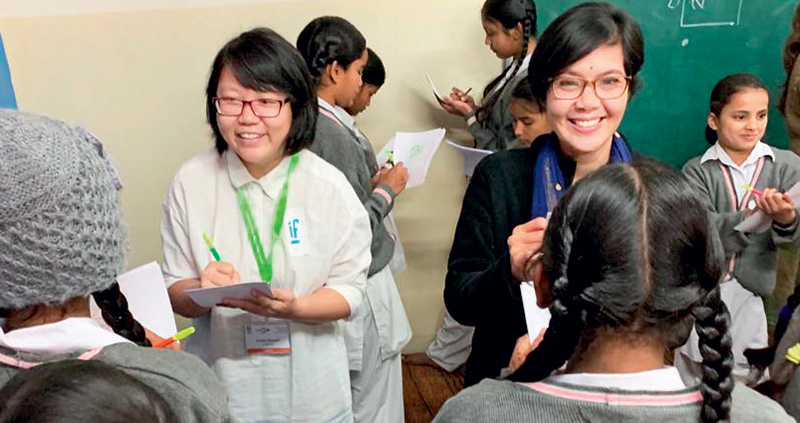
The latest partnership with Ayer has spurred Lee to kick off new projects, especially in the midst of the Covid-19 pandemic. A few weeks after the start of the Movement Control Order in Malaysia, the artist and two other Malaysian A4G fellows, Arsyad Azrai and Soonufat Supramaniam, helped to translate the NW’s Art for Well- Being guides into Malay. Additionally, 2018 A4G fellows from Vietnam also helped with Vietnamese translations of the guide. These specially designed art-activity books taught children how to translate their feelings into creative works while staying within the safety of their homes during the pandemic.
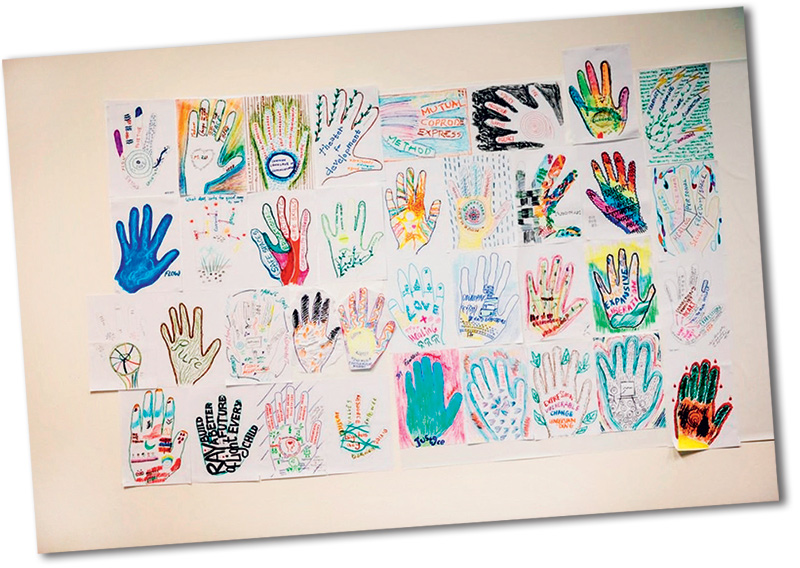
Art Lab also ignited the spark for creating special art activity guides for children at home due to the Covid-19 pandemic.
“Governments around the world take the arts very seriously to promote ideas of national identity and nationhood,” says Lee. “When you look at the history of iconoclasm, conflict and genocide, the destruction of art, language and culture brings with it the annihilation of the self and community.”
And for the participants of A4G programmes, the sense of community extends far and wide beyond any borders and barriers.
